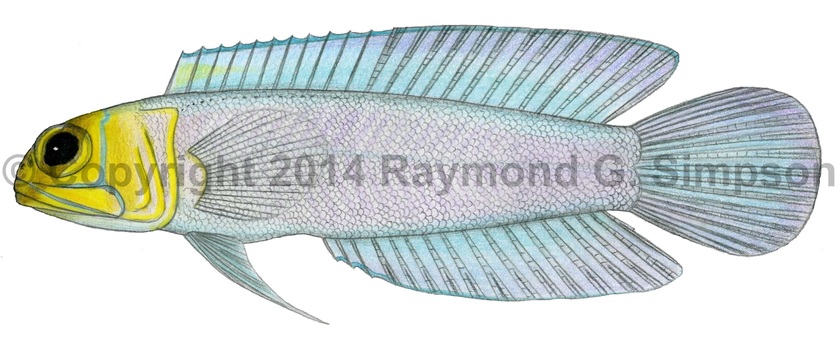
Common Name
Bluebar Jawfish
Year Described
undescribed
Identification
Dorsal Fin: XI, 14-15
Anal Fin: III, 14-15
Pelvic Fin: I, 5
Pectoral Fin: 18-21
Gill Rakers: 41-51 (lower limb of first arch)
Vertebrae: 10 precaudal, 17 caudal; 27 total
Maxilla of males without thin, flexible posterior extension. Jaws huge; reaching well past rear margin of orbit. Premaxillary and dentary with teeth. Vomer with 0-2 teeth. Lateral line extends posteriorly to between 5th and 8th segmented dorsal ray. Nape, head, pectoral base, and area above lateral line scaleless. Rest of body fully scaled. Lateral scale rows: 66-76. Dorsal fin spines slender with sharp, flexible tips. Anterior nostril without a cirrus. Median fins broad and rounded. Pelvic fin elongate. Caudal fin large and rounded.
Color
Body pearly white with faint blue to turquoise hues, and faint white chevrons on mid-side. Head whitish with a straw yellow band running through eye onto jaw. A conspicuous vertical blue line behind orbit and other scattered blue markings around mouth. Anterior dorsal fin turquoise, grading to bright blue rearward. Rest of fins bright blue. Pectoral fin whitish.
Size
Maximum size to 97mm SL.
Habitat
A shallow water jawfish living in sandy bottoms. Hovers vertically over burrows in substrate.
Range
Known from the southern Caribbean Sea to northeastern and southern Brazil, including the Fernando de Noronha and Trindade Islands (see notes).
References
Smith-Vaniz, W. F. 1997. Five new species of jawfishes (Opistognathus: Opistognathidae) from the western Atlantic Ocean. Bulletin of Marine Science v. 60 (3): 1074-1128.
Smith-Vaniz, W.F., Tornabene, L., & R.M. Macieira. 2018. Review of Brazilian jawfishes of the genus Opistognathus with descriptions of two new species (Teleostei, Opistognathidae). ZooKeys, (794), 95.
Other Notes
This undescribed species is closely related to Opistognathus aurifrons and the characters that differentiate it from that species have not been formally published. There appear to be two distinctive color variations in Brazilian waters corresponding to mainland and oceanic island populations, but these morphos are also known from the southern Caribbean islands too. The “Bluebar Jawfish” from Brazil have 17 caudal vertebrae versus Caribbean Yellowhead specimens that have 16, but some “Bluebar” colored individuals from the S. Caribbean have the “Yellowhead” number of caudal vertebrae. There is also a plain “Dull Yellowhead” morph from Brazilian islands with short pelvic fins but sharing the vertebral counts of the Brazilian “Bluebar”. They differ slightly in genetic divergence. The complex needs greater study as explained in Smith-Vaniz et al. (2018).